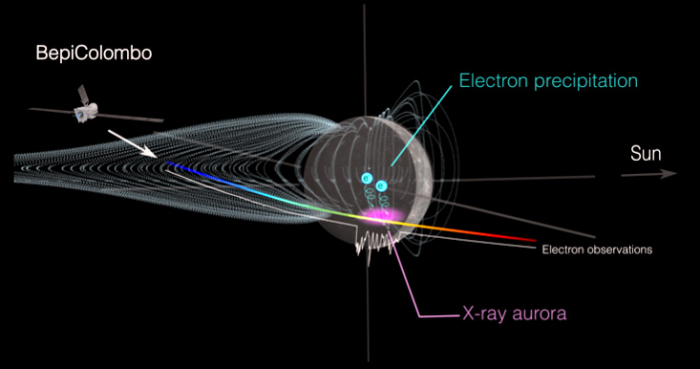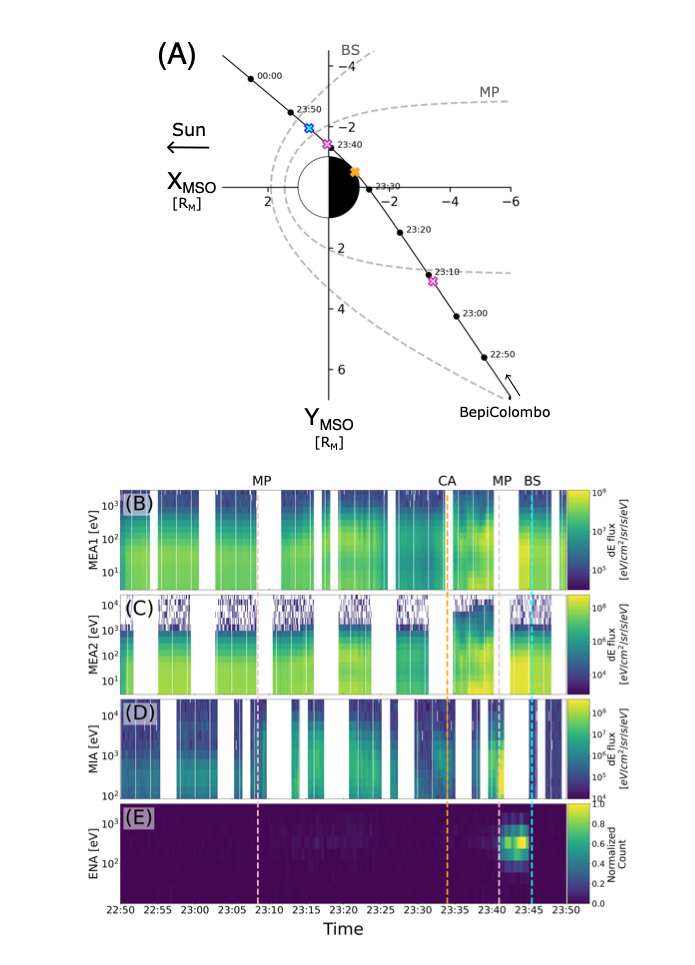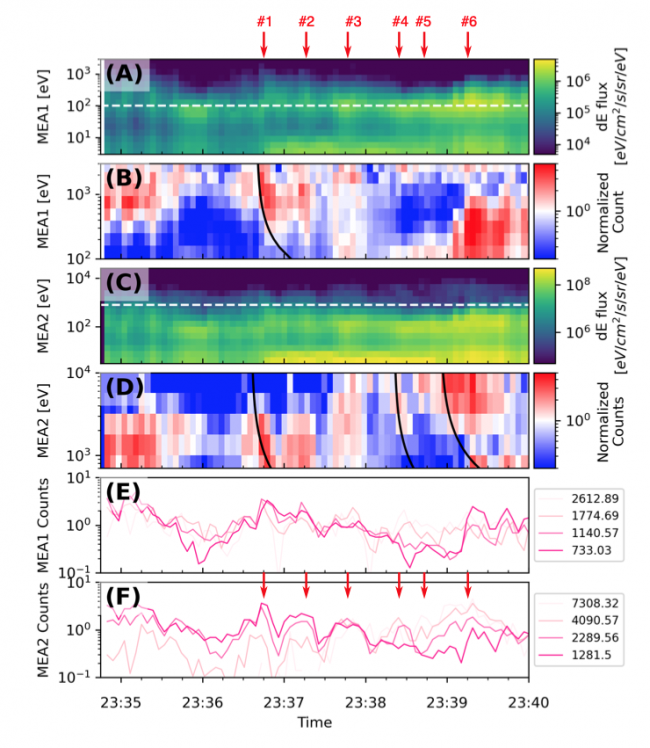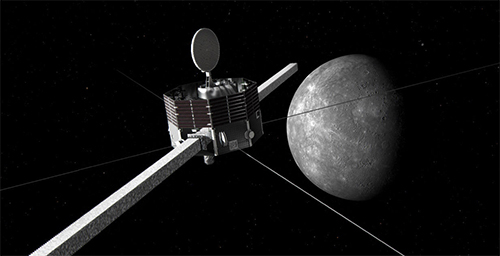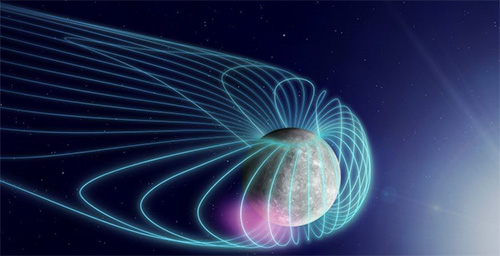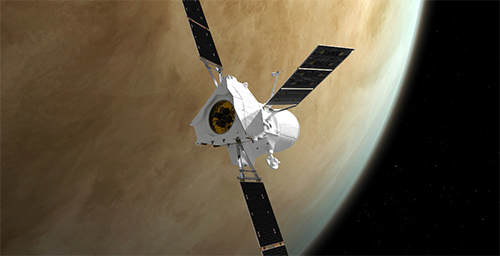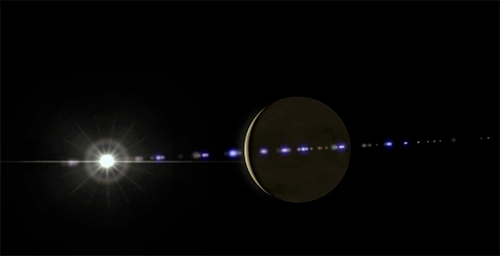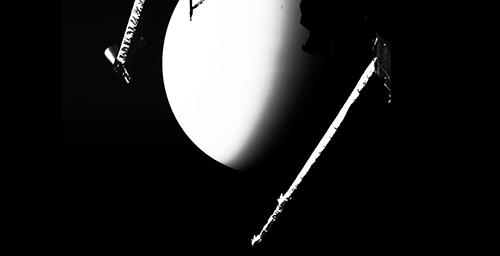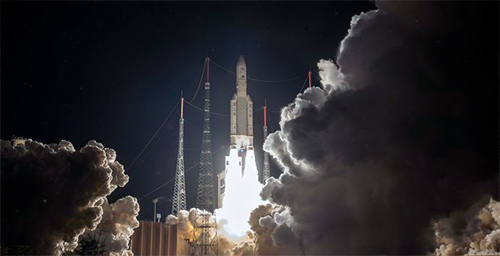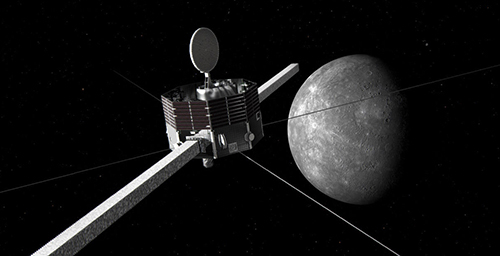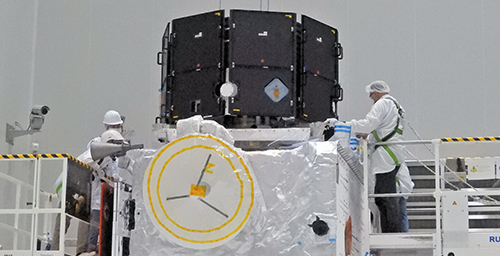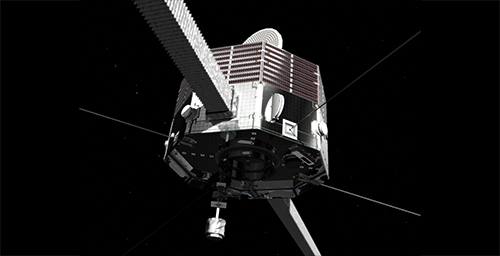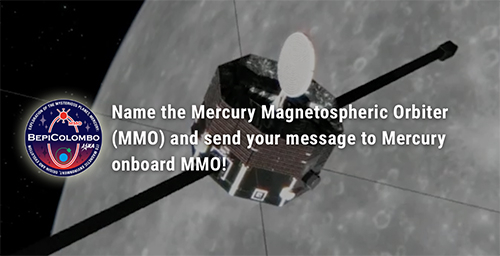(Credit: Sae Aizawa)
Overview
Mio is the Japanese Mercury orbiter onboard the BepiColombo collaborative mission between the European Space Agency (ESA) and Japan Aerospace Exploration Agency (JAXA). On October 1, 2021, BepiColombo successfully completed the first Mercury flyby, during which the spacecraft passed close to the planet in order to adjust its velocity in preparation to deliver the orbiters to Mercury in 2025. Detailed analysis of the observed plasma data captured by Mio revealed that Mio had witnessed for the first time the moment when electrons were accelerated in the magnetosphere and precipitated onto the planet's surface. The infalling electrons generated an X-ray aurora on the planet surface, suggesting a universal mechanism for exciting auroras, even for magnetic environments very different from that of the Earth.
Planets with a magnetic field are surrounded by a magnetosphere, where the influence of the magnetic force can be felt. The magnetosphere undergoes changes during to variations in the solar wind, which consists of high energy, electrically charged particles streaming from the Sun. Within the changing magnetosphere, a range of physical processes occur that includes the acceleration and transport of plasma (electrons and positively charged ions). One notable phenomenon that results is the aurora.
Compared to the magnetosphere of the Earth, previous studies have revealed that Mercury's magnetosphere responds and changes much faster to solar wind variations. However, the resultant behavior of the plasma, particularly the negatively charged electrons, has been poorly understood due to limited opportunities for observation.
During the flyby, Mio was able to successfully directly observe the electrons in the vicinity of Mercury. The results suggest that the accelerated electrons within the Mercury magnetosphere descend onto the surface of the planet, triggering a phenomenon known as X-ray aurora, where the surface emits X-rays. These findings indicate the presence of plasma influx exciting auroras is a universal phenomenon, despite the differences in magnetospheric structures and environments among the various planets in the Solar System.
This analysis was performed by an international research team from JAXA's Institute of Space and Astronautical Science (ISAS), the French Institute of Space Astrophysics and Planetary Science (IRAP), the Laboratoire de Physique des Plasmas (LPP, France), the Max Planck Institute for Solar System Research (Germany), the Swedish Institute of Space Physics, Kyoto University, Osaka University, Kanazawa University, and Tokai University.
This research outcome has been published in the scientific journal Nature Communications by Springer, on the 18th of July, 2023.
Background: The solar wind and planetary magnetosphere
All the planets in the Solar System are exposed to high-speed plasma flows known as the solar wind, which emanates from the Sun. How this impacts the planet's environment depends on factors such as if the planet possesses a global intrinsic magnetic field like the Earth, or a thick atmosphere. Mercury is known to have a weak intrinsic magnetic field. Past studies have suggested that Mercury's magnetosphere, shaped through the interaction with solar wind, exhibits behavior similar to Earth's magnetosphere. However, since the strength of Mercury's magnetic field is only about 1/100 that of the Earth, the planet's magnetosphere is smaller, and it is believed that the relatively weak intrinsic magnetic field causes physical phenomena in Mercury's magnetosphere to occur faster and on smaller scales compared to those at Earth. Yet, the detailed mechanisms of plasma acceleration and transport in such conditions at Mercury remain poorly understood. As the only other terrestrial planet in our Solar System with a magnetic field, understanding the plasma acceleration and transport in Mercury's magnetosphere and comparing this with the Earth is crucial to understanding how the solar wind affects planet environments.
The interaction between the solar wind and the magnetosphere, as well as the changes to the magnetospheric environment associated with solar wind variations, have been studied extensively on Earth. In particular, the behavior of plasma accelerated and transported by magnetic reconnection (the connection and rearrangement of magnetic field lines) in the nightside magnetospheric tail of the Earth is a major research topic. It is well-known that when the nightside plasma precipitates into the Earth's atmosphere, it can excite auroras.
The NASA Mariner-10 and MESSENGER Mercury missions revealed that the structure of Mercury's magnetosphere is very similar to that of the Earth, despite the displacement of the magnetic field center northward from the planet's center. In the magnetospheric tail, similar to the Earth, magnetic reconnection and dipolarization (rapid changes in the shape of magnetic field lines) occur, resulting in plasma acceleration and transport. On the other hand, it is also known that the Mercury magnetosphere is smaller than the Earth's, and responds sensitively to solar wind variations. The extent and magnitude of plasma acceleration and transport in this different environment have remained unclear. In particular, when plasma is accelerated and transported toward the planet surface on the Earth, it causes auroras upon collision with Earth's atmosphere. In the case of Mercury, which has a very thin atmosphere that is referred to as the exosphere, it is predicted that when plasma precipitates to the planet's surface, the plasma particles can reach the surface without colliding with the atmosphere. Instead, the plasma hits the planet surface material to emit fluorescent X-rays. This emission phenomenon on Mercury has been observed by MESSENGER and is often referred to as X-ray aurora. But the presence of electron precipitation that excites X-ray aurora has only been indirectly discussed based on past observations. Direct observations have not been possible with the Mariner-10 and MESSENGER missions, leaving questions unanswered regarding how accelerated electrons are transported and precipitate to the specific location on Mercury and with what energy they precipitate.
Results: Observations with Mio
BepiColombo is a joint Japanese-European mission to explore Mercury. Launched from French Guiana in October 2018, and the spacecraft is currently navigating through interplanetary space towards the goal of entering Mercury's orbit in December 2025. During this journey, the spacecraft is performing a total of nine planned planet flybys to adjust its trajectory, including one flyby of Earth, two of Venus (now complete), and six of Mercury. On October 1, 2021, BepiColombo successfully conducted the first flyby of Mercury, during which scientific observations were carried out using the onboard instruments. The BepiColombo mission consists of two spacecraft: the Mercury Planetary Orbiter (MPO), led by the European Space Agency (ESA), and the Mercury Magnetospheric Orbiter (MMO, named Mio after launch), led by the Japan Aerospace Exploration Agency (JAXA). This mission is groundbreaking as it is the first time in history that two orbiters have been simultaneously sent to a planet other than Earth. During the cruise phase before reaching Mercury, the two spacecraft travel in a docked configuration. Due to the sunshield covering Mio, there are significant constraints on scientific observations including the limited field of view. Nevertheless, during the planetary flybys, many of the onboard instruments are activated to allow for scientific observations. During the first Mercury flyby, the spacecraft approached as close as 200 km to the planet's surface and successfully observed the plasma in the magnetosphere. Previous missions like Mariner-10 and MESSENGER were unable to observe the southern hemisphere of Mercury's magnetosphere at low altitudes due to their orbital constraints. Thus, the observations conducted by BepiColombo are a pioneering endeavor.
In this study, the electron analyzer (MEA), ion analyzer (MIA), and neutral particle analyzer (ENA) onboard Mio were utilized, enabling the first simultaneous observations of electrons and ions at Mercury. The data analysis was aided by the previously developed magnetic field model for the planet (KT17), and the behavior of accelerated electrons precipitating towards the planet's surface on the morning side of the southern hemisphere was directly observed.
During the Mercury flyby, BepiColombo approached the planet from the night side of the northern hemisphere, made its closest approach near the morning side of the southern hemisphere, observed the magnetosphere on the daytime side of the southern hemisphere, and then followed a trajectory leading it back to the solar wind. Figure 1 illustrates the trajectory and the plasma observations made by Mio. Although there are temporal data gaps due to operational constraints during this flyby, Mio successfully captured the boundaries of the magnetosphere, including the magnetopause and bow shock, and confirmed that the magnetosphere was compressed and in a compact state compared to the average. Various physical processes were observed within this compressed magnetosphere. Particularly noteworthy was the quasi-periodic enhancement of high-energy electrons (1-10 keV) on the morning side of the magnetosphere after the closest approach (with a period of about 30-40 seconds), as shown in Figure 2. These observations resembled the phenomenon known as high-energy electron bursts (10-100 keV) previously measured by Mariner 10 and MESSENGER. However, detailed analysis revealed that the period of electron flux enhancement in the range of 1-10 keV did not match the previously reported periods, and it was also observed that the flux enhancement started at high energies and transitioned to lower energies (indicated by the black lines in Figure 2B and 2D). These findings indicate that the observed phenomena differ from those previously observed. Additionally, by examining where the electrons were transported from using the magnetic field model, it was discovered that the behavior of the electrons observed during this flyby is likely a result of the acceleration and transport due to plasma phenomena such as magnetic reconnections and dipolarizations on the dawn side of Mercury's magnetosphere.
Figure1:Overview of (A) BepiColombo trajectory and (B) Plasma observation. Identified magnetopause (MP) and bow shock (BS) are marked by pink cross/lines and blue cross/lines, respectively [Aizawa et al., 2023].
Figure 2:Electron flux enhancement (#1-#6) observed on the dawn side of Mercury's magnetosphere and energy dispersed signatures (black lines). (A), (C) are electron observations by MEA1 and MEA2, respectively, and (B), (D) are normalized counts by average count of the time interval shown in this plot. By comparing with average counts, it is seen that electron flux varies in time from high-energy to low-energy (shown by black lines). (E) and(F) are counts from MEA1 and MEA2, respectively, and showing that we have count enhancement where we see the flux enhancement [Aizawa et al., 2023].
Scientific significance of this study
Enhancements in high-energy electron flux (1-10 keV) that could be attributed to plasma processes in the tail region of Mercury's magnetosphere have been observed. This location coincides with the emission position of X-ray auroras observed from the surface of Mercury by MESSENGER. The characteristics of the flux enhancement, which exhibits quasi-periodic variations and energy dependence, suggest the observation of electrons that are accelerated and transported through magnetic reconnection and dipolarization processes in the magnetotail, eventually precipitating to the planet's surface.
On Earth, the acceleration and transport of plasma in the magnetotail result in the entry into the Earth's atmosphere, generating auroras. The findings from BepiColombo indicate that even in the smaller magnetosphere of Mercury compared to Earth, electrons are accelerated and transported in a mechanism highly similar to that on Earth, and are capable of precipitating to the planet's surface and generating X-ray auroras. This study reveals that electrons in Mercury's small magnetosphere are accelerated in the morning-side tail region close to the planet and transported to the vicinity of the planet. While magnetized planets in the Solar System differ in terms of their intrinsic magnetic field strength, presence of an atmosphere, and presence of radiation belts, accelerated electrons have now been observed to be transported to the vicinity of the planet and precipitate in all cases except for Neptune, indicating that these processes are a universal mechanism for aurora generation.
Understanding the behavior of electrons in the Mercury magnetosphere is one of the important scientific challenges addressed by Mio, which is the first spacecraft to be equipped with the relevant observational instruments. Despite the significant constraints on observations during the flyby, obtaining results regarding the long-debated physical processes in the Mercury environment increases expectations for comprehensive observations after the insertion into Mercury's orbit.
Future Prospects
After completing the first Mercury flyby demonstrated in this study, BepiColombo conducted a second and third flyby of Mercury in June 2022 and June 2023, respectively. A number of scientific observations have been carried out during each flyby, and the team is actively engaged in analyzing the data. The combination of the unprecedented scientific instrument package and the flyby trajectory has led to new discoveries that were not possible with previous missions like Mariner-10 and MESSENGER.
After the insertion into Mercury's orbit planned for December 2025, the two orbiting spacecraft will conduct observations independently. However, there are also detailed discussions for collaborative observation plans between Mio, which will observe the solar wind, and MPO, which will observe the Mercury environment. Additionally, collaborative observations with spacecraft exploring the inner heliosphere, such as ESA's Solar Orbiter and NASA's Parker Solar Probe, are widely discussed. These efforts are expected to advance Solar System exploration by bridging observations of the heliosphere, planetary regions, and planetary magnetospheres.
Journal paper information
Paper title:Direct evidence of substorm-related impulsive injections of electrons at Mercury
Journal title:Nature Communications
DOI:10.1038/s41467-023-39565-4

